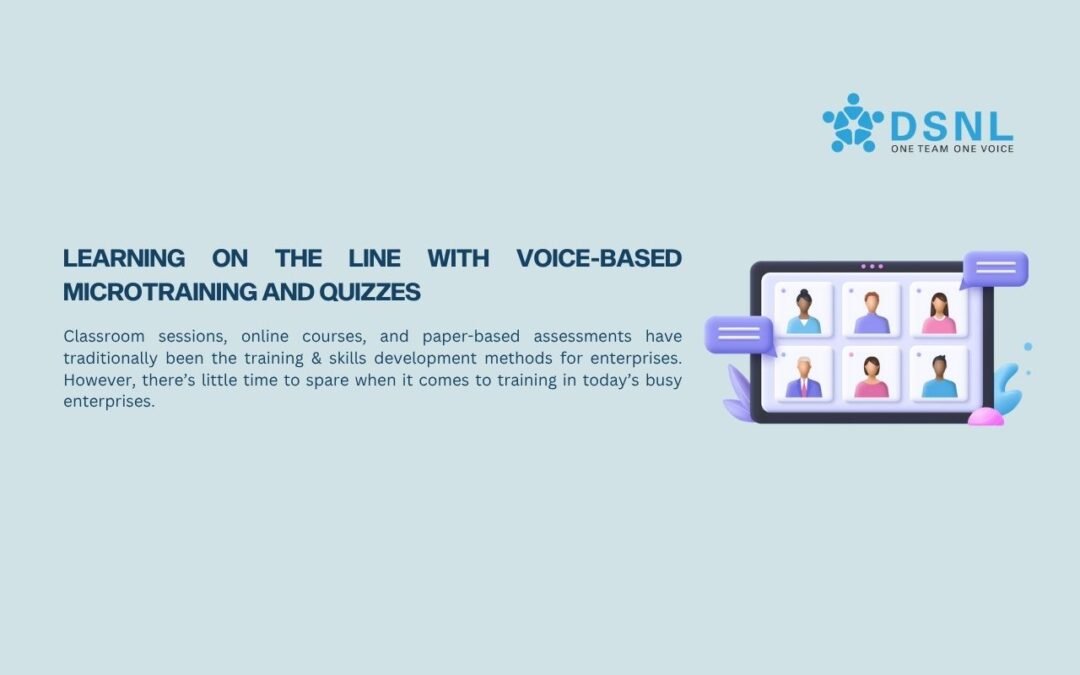Classroom sessions, online courses, and paper-based assessments have traditionally been the training & skills development methods for enterprises. However, there’s little time to spare when it comes to training in today’s busy enterprises.
Businesses can deploy an on-demand, interactive training program by leveraging telephony media with microtraining — small yet concise learning experiences. Combined with a quiz format, microtraining can optimize training & make it effective.
Voice: An Alternative Medium for Learning
Voice is a natural, friendly communication medium. Voice takes an organic form and is easily consumed compared to screen-based channels. Microtraining on the go can be the new normal to help busy employees learn while driving or walking to work.
Learners can be made to receive targeted lessons in audio format based on their role, department, or knowledge. Additionally, a quiz mechanism can be used with a voice-based learning management system to enable simple exercises like making a voice call for the response.
Advantages of Microtraining
Microtraining offers many advantages, such as better retention and flexibility. Large concepts and information can be consumed easily as it is made accessible in the form of short learning modules. Better flexibility is another advantage, as workers can take up training sessions at a time that suits them. It allows users to set up their own timelines as well.
As a result, frequent daily or weekly training modules are more useful than the old, irregular, long courses. Continuous reinforcement in a split-time format can be more suitable to enhance the learning speed and retention for enterprises that use voice as a learning medium.
Microtrain & Skill Quizzes for Interactive Learning
Quizzes can be a really good way to reinforce voice learning. Quizzes will ensure employees are more attentive to the lessons, given that voice calls don’t have a rewind or replay option. Real-time scorecards on lessons can be a good way for employees to review their progress. These interactions will result in an increase in engagement with the training system.
Scaling Voice-Based Microtraining for Enterprises
One of the biggest benefits of deploying voice media for microtraining is the scalability of the learning system. An enterprise can broadcast training content to hundreds of users simultaneously, a benefit that was difficult to achieve with in-person classrooms.
Telephony, when used for employee learning, will be able to broadcast scalable training modules in any industry, across geographies. The distributed workforce of today will find telephony to be a great learning enabler and a good fit to scale training across the employee population.
Gamification to Increase Engagement
Gamification can be integrated with voice-based skill quizzes to offer incentives like a scoreboard, ranking, and virtual badges. These can be useful to gamify and simplify learning while scoring points in a fun, competitive environment.
The practice of rewarding learners in a gaming environment can make the learning process more interactive and exciting for the employee as well. These automated rewards can also be used to target courses to employees and encourage frequent interactions, further helping in skill retention.
Conclusion
Voice-based training & quizzes are the emerging practice of on-demand learning that can be combined with the concept of microtraining to let workers learn on the go, while multitasking and without taking up too much of their time.
Employees can learn effectively in an interactive and adaptive way, with a flexible learning model that can be used to acquire skills at their own pace and convenience. Microtrainings can be more engaging for the workforce if they are gamified with rewards. Partner with DSNL to get microtraining and quiz services on the voice channel.

